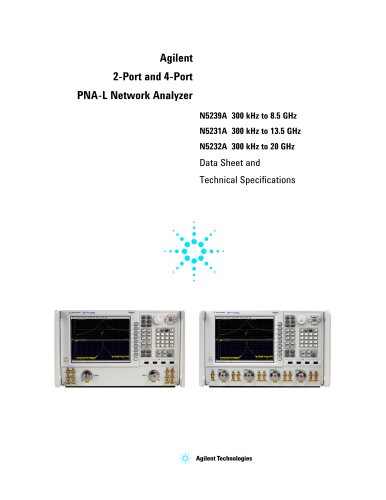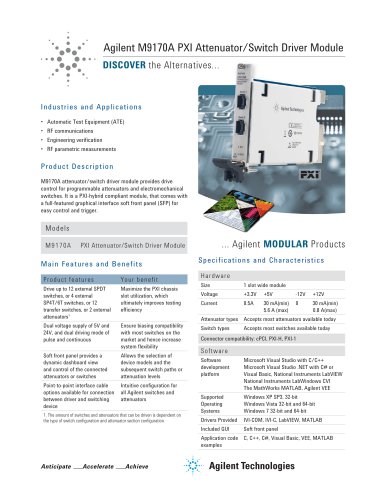
Catalog excerpts

Agilent Technologies Kapillar Elektrophorese Page 1
Open the catalog to page 1
Einführung 2009 Agilent Innovations Seminar
Open the catalog to page 2
Capillary Electrophoresis Principle Ideal for charged or polar samples For charged substances like biomolecules, small basic or acidic drugs and ions, there’s nothing faster or easier • Separation based on compound mobility (mass/charge) in an electrical field • High resolution separations (usually >> 40,000 plates) • Fast separation (few minutes) • Smallest sample volumes (few µL) • Less sample prep required (no stationary phase, just an open glass tube) • Orthogonal technique complementing HPLC • Low consumption of sample and buffer (green method) Page 3
Open the catalog to page 3
Capillary Electrophoresis - basics Historical background, current Status and Electrophoresis as a Separation technique was introduced by Tiselius in 1937. For this work he was awarded a Nobel Prize. Separation efficiency in free Solution - limited by thermal diffusion and convection In the early 1980s Jorgenson and Lukacs advanced the technique by using 75-u.m i.d. fused silica capillaries. Jorgenson also clarified the theory, described the relationships between operational parameters and Separation quality, and demonstrated the potential of capillary electrophoresis (CE) as an analytical...
Open the catalog to page 4
Capillary Electrophoresis for charged samples try CE first! • CE offers fast separations with exceptional efficiency & resolution for analytical challenges that often can only be met with difficulty by LC • For charged substances like biomolecules, small basic or acidic drugs and ions, there’s nothing faster or easier • In addition, CE uses low amounts of sample and much less buffer than LC • CE complements LC for analysis of small charged, chiral or polar molecules & ions • Orthogonal technique to LC • Low consumption of sample and buffer
Open the catalog to page 5
CE avoids laminar flow profiles (typical in HPLC). This enables high resolution Flow velocity profiles and Corresponding solute zones in electro and pressure driven flow.
Open the catalog to page 6
CapHlary wall Diffuse layer Stern layer
Open the catalog to page 7
Capillary Electrophoresis - technical Designs of flow cells UV detection is based on the Lambert-Beer law that states that sensitivity is directly proportional to the length of light path within a detector cell. In CE detection happens through the capillary where inner diameters are usually between 25 and 75 µm. This limitation was tackled by HP and later Agilent in developing extended light path capillaries for CE offering 3x or 5x the diameter of a standard capillary. Another way was the development of the HighSensitivity Cell offering a Z-shaped cell with 1.2 mm path length
Open the catalog to page 8
Fronting and tailing of solutes due to electrodispersion". Peaks: 1} Chloride, 2) Chlorale, 3) Fluoride, 4) Acetate, 5) Proprionate, 6) MES. Conditions: Detection = Indirect UV, buffer = 0.01 M benzoic acid adjusted to pH 8 with Tris and addition of 0.05 % MHEC to suppress EOF, sample concentration = 5.104 M, detection wave length = 254 nm, V - 25 kV, I - 50 cm, L - 57 cm, id = 75 um.
Open the catalog to page 9
Further reading: CE Primer For more detailed Info please request the free: Agilent High performance Capillary Electrophoresis A Primer Pub. Number: 5990-3777EN
Open the catalog to page 10
Typische Applikationen 2009 Agilent Innovations Seminar
Open the catalog to page 11
DetenniiiaiiDn of Sniall Ions by Caprllary Zone Eleclxophorests with hriirect Photometrie Non UV-absorbing UV-absorbing /\ Non UV-absorbing buffer cation buffer anion separand anion Mechanism of indirect or vacancy detection
Open the catalog to page 12
Energy Drink Cations in coffee and energy drinks
Open the catalog to page 13
Separation of short-chain carboxylic acids using the Organic Acids Solutions Kit Organic acids in beer and red wine
Open the catalog to page 14
Chiral analysis CE can provide Organic Chemists with rapid screening of chiral compounds and chiral excess determinations with minimal use of expensive chiral selectors. In CE the chiral selector is simply added to the buffer. This allows fast method development and rapid analyses at lowered cost. Chiral CE compares very favorably with HPLC Data taken from Page 149 CE-Primer: P/N 5990-3777EN Page 15
Open the catalog to page 15
Chiral analysis example A single method can be applied to a wide range of analytes. Buffer: 25mM phosphate /TEA pH 3.3, 5% (w/v) heptakis -6-sulfato-ß cyclodextrin. Capillary: 64.5 cm (56cm) x 25µm i.d. BF5 Detection: Injection: Voltage: Temperature: 200nm / 8nm, ref off 3000mbar*s 30kV 20° C Doxylamine mAU 1200 Epinephrine 3,5-DOMA Isoproterenol 1000 800 Methyl dopa 600 400 Clenbuterol Cromakalim 200 0 min Data taken from Application Note Page 16 5968-2018E
Open the catalog to page 16
Large Biomolecules Protein separation by pI value – charge heterogeneity analysis Monoclonal Ab isoform quantification. A part of an electropherogram showing assignment of mIgG1-peaks to 5 isoform groups A-E as indicated. 2009 Agilent Innovations Seminar
Open the catalog to page 17
/KKECCHSOUi iDDRADl.o BioConfirm Protein Analysis Peptide Matching Results (sequence coverage) MassHunter analyzed Peptide mapping for a BSA digest. Labeling the CE-MS electropherogram with the amino acid sequences of
Open the catalog to page 18
Single base pair Separation of ptl(A) S&condary peaks of identical base length as the primary peaks, but retarded in terminal 5' phosphate group Oligonucleotide samples with or without terminal 5 phosphate group
Open the catalog to page 19
Metabolomlc Proflllng of Anlonlc Metabolites by CaplHary Electrophoresls Mass Spectrometry Temoyoshi Sogj,*'* Kaori Igara&hi.f Chiham lto,+ Katsno MizobuchM Hans-Peter Zimmermann,1 rnsitfüt tir Advanced Sosäences. Keio Universtiy. Tstruoka. YamagalB 997-0052 Japan, Agüent Technologies. 9-i Takakofa-cho. Hachioß. Tokyo 192S5iO Japan, and Agilen} Technnlogies. Hennlen-Packani-Stfasse S.
Open the catalog to page 20
Vergleich CE vs HPLC 2009 Agilent Innovations Seminar
Open the catalog to page 21
Capillary Electrophoresis: Advantages Ideal for charged or polar samples Non-Laminar CE • Highest resolution, often > 100 000 plates ! • Minimal sample prep, e.g. filter and dilute High resolution due to non-laminar flow Fast separations due to high field strength, short capillaries Smallest sample volumes due to nL Injection Handles crude matrices due to no packing material less adsorption Low solvent consumption typically 2 mL buffer for several runs Orthogonal to HPLC due to a completely different separation principle Laminar HPLC
Open the catalog to page 22All Agilent Technologies - Life Sciences and Chemical catalogs and technical brochures
-
Agilent 280 Series AA Systems
12 Pages
-
Inorganic Standards
40 Pages
-
InfinityLab LC Supplies
148 Pages
-
General Chromatography
164 Pages
-
Sample Preparation (2018/2019)
144 Pages
-
MS500
12 Pages
-
FLAME ATOMIC ABSORPTION SPECTROSCOPY
104 Pages
-
Agilent training
27 Pages
-
AGILENT VACUUM PRODUCTS CATALOG
536 Pages
-
Vacuum Measurement Catalog
44 Pages
-
AGILENT ION Pumps
53 Pages
-
AGILENT DIFFUSION PUMPS
35 Pages
-
AGILENT Rotary Vane Pumps
29 Pages
-
Agilent InfinityLab LC Series
16 Pages
-
3100 fractionator
8 Pages
-
4200 MP-AES
12 Pages
-
Agilent GPC/SEC Solutions
12 Pages
-
Agilent?s biomass solutions
12 Pages
-
X-ray Crystallography
12 Pages
-
Agilent ProPulse NMR System
5 Pages
-
An autosampler like no other
4 Pages
-
Agilent U1450A/U1460A
19 Pages
-
Agilent B1507A
22 Pages
-
Agilent M9703A
16 Pages
-
W1905 Radar Model Library
16 Pages
-
M8048A ISI Channels
7 Pages
-
Agilent J-BERT M8020A
27 Pages
-
Agilent N8900 Series
10 Pages
-
I/O Hardware
16 Pages
-
Advanced Design System
16 Pages
-
RF & Microwave Attenuators
4 Pages
-
E4980AL Precision LCR Meter
8 Pages
-
FieldFox Handheld Analyzers
8 Pages
-
AFM/SPM Accessories
20 Pages
-
VEE 9.32
24 Pages
-
89600 VSA Software
9 Pages
-
Command Expert
2 Pages
-
E5061B Network Analyzer
8 Pages
-
E5071C ENA Network Analyzers
18 Pages
-
N9038A MXE EMI Receiver
2 Pages
-
N9322C Basic Spectrum Analyzer
10 Pages
-
Digital Multimeters
25 Pages
-
M9361A PXI Downconverter
2 Pages
-
Power Meters and Power Sensors
34 Pages
-
E7515A UXM Wireless Test Set
2 Pages
-
Agilent Power Products
31 Pages
-
E5063A Network Analyzer
8 Pages
-
Leak Detection Catalog
41 Pages
-
Agilent 7820A GC brochure
8 Pages
-
Agilent GC-MSD and QTOF
96 Pages
-
Agilent GC-MSD 5977
39 Pages
-
Agilent Intro BERLIN
24 Pages
-
1290 Infinity Quaternary LC
24 Pages
-
1260 Infinity Bio-inert
26 Pages
Archived catalogs
-
Diffusion Pumps Catalog
37 Pages






















































































































































